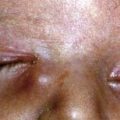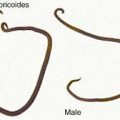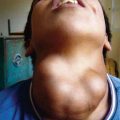Chapter 542 History and Physical Examination
Gynecologic Examination
Neonates
The clitoris may appear large in proportion to the other genital structures, especially in premature infants. If the clitoris appears enlarged, the clitoral width should be measured; values >6 mm in a newborn indicate a need for further evaluation. If clitoromegaly and ambiguous genitals are present, the immediate concerns of the obstetrician and pediatrician are to obtain expert consultation for the infant and to counsel the parents. Congenital adrenal hyperplasia is the most common cause of ambiguous genitals (accounting for >90% of cases), and salt-wasting forms can lead to rapid dehydration and fluid and electrolyte imbalance (Chapter 570). Delay of diagnosis and treatment of congenital adrenal hyperplasia may be life-threatening.
Infants and Prepubertal Girls
As puberty approaches, the child experiences increasing endocrine activity of the hypothalamus, pituitary gland, adrenal gland, and ovaries (Chapter 555). The labia majora begin to fill out and the labia minora thicken and elongate as a result of increased estrogen levels. The hymen thickens and becomes more redundant. Clear or white physiologic secretions may be present. Breast buds begin to appear, initially with one side first, or as a pair.
Adolescents
Some teens prefer to initially meet and discuss the reason for their visit with the provider without their parent or guardian, and this request should be honored (Chapter 106). Most of the time, obtaining a history from an adolescent begins with meeting the patient and her parent or caregiver together to review her history and the reason for the visit and to explain the concepts of confidentiality and privacy. Familiarity with local laws governing limitations to confidential services should guide the protection of teens’ and parents’ rights to information access and privacy. The Guttmacher Institute provides an up-to-date listing of state and federal laws in the USA affecting confidentiality (http://www.guttmacher.org/statecenter/spibs/index.html). Brief discussions of normal pubertal development and menstruation can reassure both patients and parents or guardians and provide valuable education on appropriate menstrual flow, menstrual hygiene, and the duration and frequency of bleeding. Introducing the menstrual diary as an invaluable tool for the teen can help patients, parents, and clinicians identify abnormal bleeding patterns that might require further evaluation.
A number of resources for educating adolescents regarding their first pelvic examination and in-depth sexual history and psychosocial screening tools are available. These include the North American Society for Pediatric and Adolescent Gynecology (http://www.naspag.org), the Society for Adolescent Health and Medicine (http://www.adolescent.health.org), the Association of Reproductive Health Professionals (http://www.arhp.org), and GYN101. The “Tool Kit for Teen Care, 2nd edition” is available through the American College of Obstetricians and Gynecologists; it includes information on how to establish an office-friendly environment for the adolescent gynecologic evaluation, tools for adolescent assessment, suggestions about how to talk with teens, handouts for adolescents, and a number of resources for health care professionals (http://www.acog.org/departments/adolescentHealthCare/TeenCareToolKit/generalBrochure.pdf, http://www.acog.org/departments/dept_notice.cfm?recno=7&bulletin=4798).
Pelvic Examination
Indications for the first pelvic examination in adolescents are presented in Table 542-1: abnormal uterine bleeding, vulvovaginitis, severe dysmenorrhea, or abdominal pain. If an adolescent does not meet one of the criteria listed in Table 548-1, ACOG recommends that the first “gynecologic encounter” occur between the ages of 13 and 15 yr (Table 542-2). Patients should undergo screening for sexually transmitted infection (STI) with each new sexual partner, but with the availability of urine and vaginal swab nucleic acid amplification testing for chlamydia and gonorrhea, STI screening does not necessitate a speculum exam.
Table 542-1 SUGGESTED INDICATIONS FOR PELVIC EXAMINATION IN ADOLESCENTS
Modified from American College of Obstetricians and Gynecologists: Committee opinion no. 460: the initial reproductive health visit, Obstet Gynecol 116:240–243, 2010.
Table 542-2 RECOMMENDATIONS FOR FIRST GYNECOLOGIC EVALUATION
Data from American College of Obstetricians and Gynecologists Committee on Gynecologic Practice: ACOG Committee Opinion No. 483: Primary and preventive care: periodic assessments, Obstet Gynecol 117:1008–1015, 2011.
Allen L, Fleming NA, Strickland J. Adnexal masses in the neonate, child, and adolescent. In: Sanfilippo JS, Lara-Torre E, Edmonds K, Templeman C, editors. Clinical Pediatric and Adolescent Gynecology. New York: Informa Healthcare; 2009:417-426.
American College of Obstetricians and Gynecologists. Breast concerns in the adolescent. ACOG Committee on Adolescent Health Care opinion no. 350. Obstet Gynecol. 2006;108:1329-1366.
American College of Obstetricians and Gynecologists. The initial reproductive health visit. ACOG Committee Opinion No. 335. Obstet Gynecol. 2006;107:745-747.
American College of Obstetricians and Gynecologists. Tool kit for teen care, ed 2. Atlanta: American College of Obstetricians and Gynecologists; 2009.
Braverman PK, Breech L. The Committee on Adolescence: Clinical report—gynecologic examination for adolescents in the pediatric office setting. Pediatrics. 2010;126(3):583-590.
Emans SJ. Office evaluation of the child and adolescent. In: Emans SJ, Laufer MR, Goldstein DP, editors. Pediatric and adolescent gynecology. ed 5. Philadelphia: Lippincott Williams & Wilkins; 2005:1-48.
Jamieson MA. Vaginal discharge and genital bleeding in childhood. In: Sanfilippo JS, Lara-Torre E, Edmonds K, et al, editors. Clinical pediatric and adolescent gynecology. New York: Informa Healthcare; 2009:147-148.
Lara-Torre E. The physical examination in pediatric and adolescent patients. Clin Obstet Gynec. 2008;51:205-213.
Lin-Su K, Neu ML. Diagnosis and management of congenital adrenal hyperplasia. In: Altchek A, Deligdisch L, editors. Pediatric and adolescent gynecology. Oxford, England: Wiley Blackwell; 2009:29-30.
Merritt DF. Genital trauma in children and adolescents. Clin Obstet Gynecol. 2008;51:237-248.

 in wide × 4 in long) or Pedersen (
in wide × 4 in long) or Pedersen ( in wide v 4 in long). Shorter speculums will not allow visualization of the entire vaginal canal. The adolescent patient should be reassured that the exam may be uncomfortable but should not be painful and that her request to stop or wait will be honored. Encouraging the patient to watch with a hand-held mirror facilitates patient education and can be empowering. She may be told before the insertion of the speculum that she will experience a pressure sensation. Before touching the introitus, it may be useful to touch the inner thigh with the speculum. One should avoid compression of the urethra. Gentle pressure with a finger or displacement of the fourchette posteriorly further facilitates proper speculum placement. After visualization of the vagina and cervix, specimens can be obtained as indicated. A bimanual examination, sometimes with a single digit, allows palpation of the vaginal walls and cervix and bimanual assessment of the uterus and the adnexa.
in wide v 4 in long). Shorter speculums will not allow visualization of the entire vaginal canal. The adolescent patient should be reassured that the exam may be uncomfortable but should not be painful and that her request to stop or wait will be honored. Encouraging the patient to watch with a hand-held mirror facilitates patient education and can be empowering. She may be told before the insertion of the speculum that she will experience a pressure sensation. Before touching the introitus, it may be useful to touch the inner thigh with the speculum. One should avoid compression of the urethra. Gentle pressure with a finger or displacement of the fourchette posteriorly further facilitates proper speculum placement. After visualization of the vagina and cervix, specimens can be obtained as indicated. A bimanual examination, sometimes with a single digit, allows palpation of the vaginal walls and cervix and bimanual assessment of the uterus and the adnexa.




